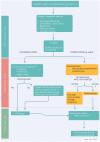Management of Kidney Stone Disease in Pregnancy: A Practical and Evidence-Based Approach
- PMID: 36197640
- PMCID: PMC9732063
- DOI: 10.1007/s11934-022-01112-x
Management of Kidney Stone Disease in Pregnancy: A Practical and Evidence-Based Approach
Abstract
Purpose of review: Suspected kidney stone disease during pregnancy is a difficult condition for health professionals to manage. This is partly due to the more limited range of diagnostic and therapeutic strategies, which can be safely applied. A comprehensive review of literature was performed to identify evidence to develop a practical guide to aid clinicians.
Recent findings: Ultrasound remains the recommended first line option for imaging. Complicated cases, such as suspected infected obstructed system, require urgent decompression such as in the form of percutaneous nephrostomy. This article highlights the pharmacotherapeutic agents, which are considered safe for use in pregnancy. Where surgical intervention is indicated, evidence supports ureteroscopy to be a safe option as long as infection has been treated. Ureteroscopy can offer definitive clearance of the stone(s) and can be less burdensome regarding bothersome symptoms compared to indwelling ureteral stent or nephrostomy, which also require regular exchange due to the high propensity for encrustation in pregnancy. A multidisciplinary approach is fundamental to safely manage suspected kidney stone disease in pregnancy. Adoption of a locally agreed pathway as suggested in this article supports improved patient care.
Keywords: Pregnancy; Renal colic; Ureteroscopy; Urolithiasis.
© 2022. The Author(s).
Conflict of interest statement
None of the authors have any conflicts of interest to declare relevant to this article. The figure is original and has been created for educational purposes using the software Visme.
Figures
References
Publication types
MeSH terms
LinkOut - more resources
Full Text Sources
Research Materials


